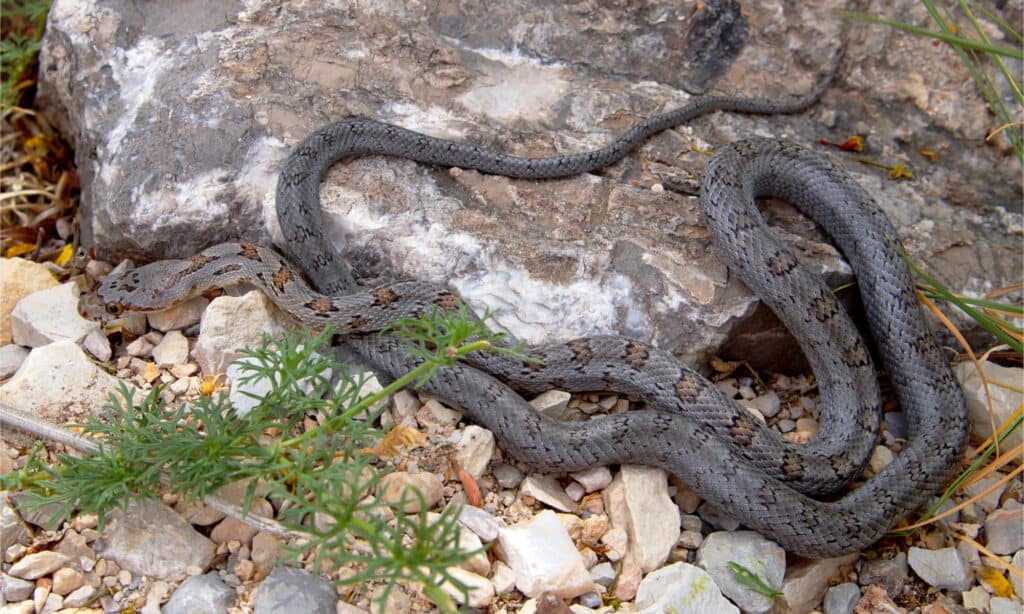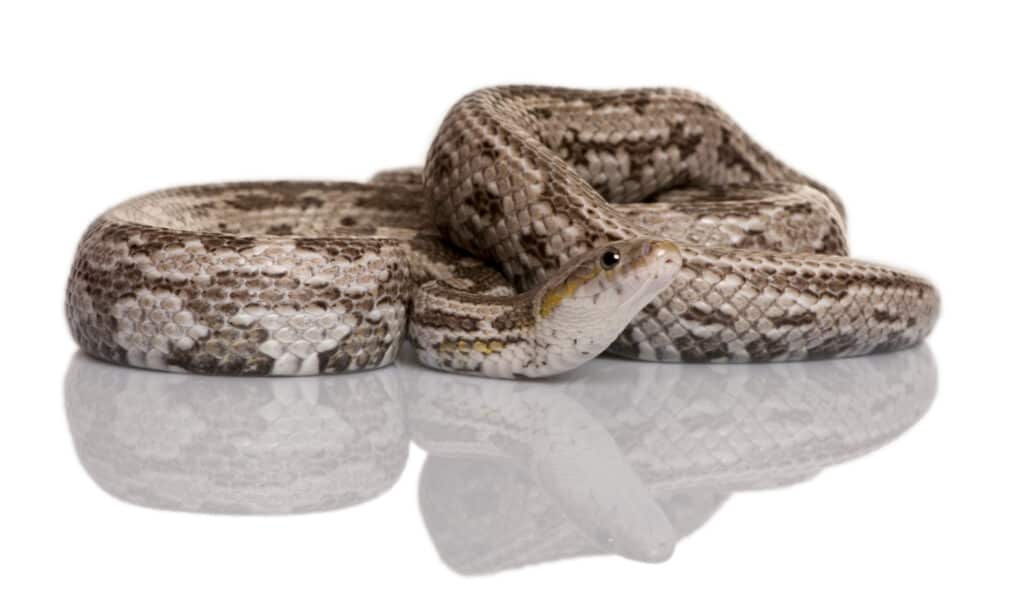The Baird’s rat snake is a harmless medium-sized snake endemic to the southwestern United States and parts of Mexico. It was named after American naturalist Spencer Fullerton Baird, from where some of its other names, including Baird’s pilot snake and Baird’s Coluber, were derived.
The Baird’s rat snake is a species of colubrid snake belonging to the genus Pantherophis, which refers to the markings on the body of some snakes in this group. Their colorful body pattern, calm disposition, and easy care make them suitable pet snakes. They are for sale in certain pet stores across the United States. Even though they’re relatively small snakes, how big can they get? Read on to find out.
Where to Find Baird’s Rat Snakes

Baird’s rat snakes can be found in northern parts of Mexico, in the Mexican states of Nuevo León, Coahuila, and Tamaulipas.
©Matt Jeppson/Shutterstock.com
The Baird’s rat snake (Pantherophis bairdi) is native to the Big Bend region of western Texas in the United States – this is why they’re also referred to as the Great Bend rat snake. They can also be found in northern parts of Mexico, in the Mexican states of Nuevo León, Coahuila, and Tamaulipas.
The Baird’s rat snake is considered highly elusive and difficult to encounter in the wild. Their preferred habitats are semi-arid areas, deserts, and rocky mountainous regions. They’re also known to live in forests, shrublands, woodlands, and areas with crevices, caves, and limestone canyons. This species of snake prefers a partly arboreal habitat.
Baird’s rat snakes have a lifespan of 8-16 years long.
How to Identify Baird’s Rat Snakes

Baird’s rat snakes have four dark stripes that run along the entire length of the body.
©Eric Isselee/Shutterstock.com
Baird’s rat snakes are beautiful snakes with a combination of colors. Rat snakes are generally known to have blotches or stripes on their body. However, you can identify Baird’s rat snake by its orange, yellow, or dark salmon dorsal color pattern with four stripes running from its neck to tail. Their belly is typically gray to yellow, darkening towards the tail.
These snakes have prominent eyes and a small head with little distinction from the neck. Meanwhile, they have no feet. Juveniles have orange or brown bands on their body which disappear with age.
What is the largest Baird’s Rat Snake Ever Recorded?

Adults Baird’s rat snakes may reach 25 to 55 inches (64 to 140 cm) in total body length.
©Rusty Dodson/Shutterstock.com
Baird’s rat snakes are a relatively medium-sized species, with adults typically growing to lengths of between 2 and 5 feet. There is no exact data on the largest Baird’s rat snake ever recorded. However, adults may reach 25 to 55 inches (64 to 140 cm) in total body length (including tail), while hatchlings (young ones) measure 11.8 inches (30 cm) on average. Generally, rat snakes weigh around 1.3-4.8 lb (0.6-2.2 kg).
Are Baird’s Rat Snakes Venomous?
As is typical with rat snakes, the Baird’s rat snake is not venomous. They are also not known to be dangerous to man. However, this snake species will defend itself if it feels threatened by inflicting a painful bite. Bites are never fatal and usually do not require medical attention. Generally, Baird’s rat snakes are more pleasantly tempered than other rat snake species.
What Do Baird’s Rat Snakes Eat?
Baird’s rat snakes are carnivorous, and their primary diet consists of rodents, although they also prey on birds and small mammals. Young ones of this species often eat lizards.
Baird’s Rat snakes As Pets
The snake is known to be for sale in specialized pet stores and brought to life with people as pets. Caring for this snake species is relatively easy, and even a beginner can handle them without stress. Feed your baby snake once a week with rodents, especially rats, until adulthood feeding can be done once every 14 days. Your pet snake should be fed with a rodent slightly smaller than the snake’s girth at its largest point.
Quail, chicks, or eggs can serve as supplemental food for captive snakes. Creating a suitable environment is also essential for the well-being of your pet. Your Baird’s rat snake should be housed in an appropriately sized vivarium with adequate regulation, upgrading to larger vivariums as they grow.
The temperature in the vivarium should be maintained at around 85 – 90 F (29-32 C), using an artificial heat source when necessary. Maintaining proper temperature is essential as the snake must regulate its body temperature in a warm lying zone throughout the day.
Sufficient light should also be provided, with proper exposure to a day/night cycle. Because these snakes are a little shy, they love to hide. So you should include multiple hiding spots in the enclosure. A Baird’s rat snake thrives in humidity levels of around 50%.
You can choose substrates such as aspen bedding, cypress mulch, or coco fiber to make your closure look more natural. Substrates made of newspaper or paper towels are all good choices because they’re quick and easy to clean. Avoid using sand, pine, or cedar splinters in the substrate, as these materials are harmful to the snake.
Conservation Status of the Baird’s Rat Snake
Luckily, the IUCN Red List of Threatened Species classifies Baird’s rat snake as a species of “Least Concern” because its population is stable across its range. The IUCN also estimates that there are several thousands of these species worldwide. However, their exact adult population is unknown.
Other Record-Breaking Snakes
Shovelnose snakes are a diminutive species of snake that can be found across North America. They are generally quite small, measuring an average of only 30 cm (11.8 inches) in length, but some recording-breaking snakes have been recorded as reaching up to 43 cm (17 inches) in total length.
Despite their small size, they are highly adaptable and can thrive in a variety of habitats, including grasslands, deserts, and rocky areas. These snakes are typically light brown or tan in color, with distinctive markings on their backs that resemble the shape of a shovel.
While some shovelnose snakes may reach a length of up to 17 inches, most adults fall within the range of 10 to 17 inches in length.
The photo featured at the top of this post is © Rusty Dodson/Shutterstock.com
Discover the "Monster" Snake 5X Bigger than an Anaconda
Every day A-Z Animals sends out some of the most incredible facts in the world from our free newsletter. Want to discover the 10 most beautiful snakes in the world, a "snake island" where you're never more than 3 feet from danger, or a "monster" snake 5X larger than an anaconda? Then sign up right now and you'll start receiving our daily newsletter absolutely free.
Thank you for reading! Have some feedback for us? Contact the AZ Animals editorial team.






